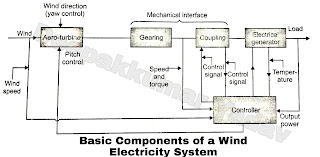Block Diagram and Working of Wind Energy Plant and its Applications
Q. Working Principle of Wind Turbine
Q. Block Diagram of Wind Energy Plant
Q. Block diagram of wind turbine The rotor power
Q. Wind power generation
- The main components of a WECS (Wind Energy Conversion System) are shown in Figure, In block diagram form. In brief the system operation can be stated as follows :
- Aeroturbines convert energy in wind to rotational mechanical energy. They require pitch control and yaw control (only in case of horizontal or wind axis machines) for proper operation.
- A mechanical Interface consisting of a step-up gear and a suitable coupling converts the rotational mechanical energy to an electrical energy, by use of an electrical generator. The output of this generator is connected to the load or power grid, as per the requirement
- For localities, with the prevailing wind in one direction, the design of turbine is simplified, where In the rotor is in fixed orientation with the swept area perpendicular to the predominant wind direction.
- Such a machine is said to be "Yaw fixed'. Most wind turbines are yaw active, i.e. as the wind direction changes, a motor rotates the turbine slowly about the vertical axis (or yaw) so as to face the blades into the wind. The area of the wind stream swept by the wind rotor is then maximum.
- In small turbines, yaw action is controlled by a tall vane. In larger machines a servo mechanism operated by a wind direction sensor controls the yaw motor that keeps the turbines properly oriented.
- The purpose of the controller is to sense wind speed, wind direction, shaft speed and torque at one or more points, power output and generator temperature as necessary and appropriate control signals for matching the electrical output to the wind energy input and protect the system from extreme conditions brought upon by strong winds, electrical faults etc.
